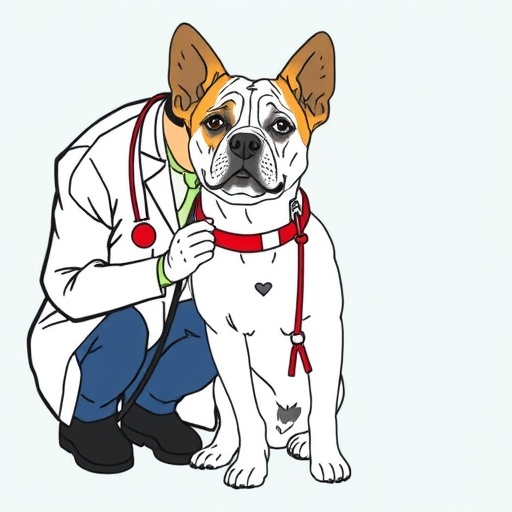In recent years, the accessibility of preventive veterinary care for dogs has become a significant concern among pet owners, public health officials, and agricultural stakeholders. A groundbreaking study conducted by researchers at The Ohio State University College of Public Health sheds new light on how widely accessible such veterinary services really are, especially focusing on the disparities between urban and rural regions across the United States. Utilizing a novel “secret shopper” methodology, the research team set out to evaluate actual access to veterinary appointments in six diverse states, providing a clearer understanding of systemic barriers and opportunities for improvement that could reverberate far beyond the veterinary sector.
The cornerstone of this research involved calling more than 5,000 randomly selected veterinary clinics across California, Minnesota, Ohio, Pennsylvania, Texas, and Washington during 2025. This approach, where researchers posed as prospective dog owners seeking preventive care appointments, allowed for an objective appraisal of how veterinary practices manage appointment scheduling in real-world scenarios. Unlike survey data relying on practitioner or client self-reporting, this real-time engagement with clinics captures the practical realities faced by pet owners in navigating veterinary services.
Findings revealed that veterinary care is generally accessible for most pet owners in well-populated areas, with 67 percent of calls resulting in secured appointments. On average, those able to schedule visits faced waiting times of approximately 6.4 days and travel distances around 6.4 miles. However, these averages mask significant disparities that surfaced when focusing explicitly on rural settings. In regions characterized by lower population density, appointment success rates dropped to less than 62 percent, alongside longer average wait times of 8.6 days and considerably increased travel distances reaching 13 miles. These data underscore the multidimensional nature of access barriers endemic to rural communities.
Several factors contributed to the inability to secure appointments, with the most common obstacles being difficulties in connecting with clinic staff or being subjected to protracted hold times exceeding five minutes—a threshold established by the study to delineate excessive waiting during phone calls. Additionally, nearly 4 percent of clinics reported having no capacity to accept new patients, highlighting a looming issue of veterinary workforce shortages. This phenomenon not only affects pet owners but can ripple across agricultural systems and public health domains, particularly given the role of veterinarians in managing zoonotic diseases and supporting food systems.
The disparities documented in this study have implications that extend beyond mere inconvenience. Timely preventive veterinary care plays a crucial role in diagnosing and managing health conditions in companion animals, effectively reducing morbidity and improving overall well-being. Delays or lack of access can exacerbate pet health problems, impacting both animals and their owners. Notably, pet ownership is linked to a host of mental and physical health benefits for humans, including reduced stress and enhanced emotional support. When pets are denied adequate veterinary care, these symbiotic benefits are compromised.
Moreover, gaps in veterinary access pose tangible public health risks. Vaccination against preventable diseases such as rabies is a critical component of safeguarding both animal and human populations. In rural areas where access to veterinary care is limited, vaccination rates may suffer, increasing the likelihood of disease outbreaks with potentially severe consequences. This intersection of animal health and public health further elevates the urgency for effective interventions aimed at improving veterinary care accessibility across all geographies.
Addressing these challenges demands systemic solutions. One promising avenue highlighted by the researchers is the expansion of veterinary education programs, particularly those emphasizing rural practice. Ohio State University’s College of Veterinary Medicine has initiated an innovative program, Protect One Health in Ohio, designed to strengthen the state’s veterinary workforce, bolster public health protections, and enhance the agricultural economy. This initiative reflects a multidisciplinary and One Health approach, recognizing the interconnectedness of human, animal, and environmental health.
The strategic focus on increasing the number of veterinarians trained to serve in underserved rural locations aims to mitigate workforce shortages and reduce access disparities. By tailoring curricula and incentives to encourage rural practice, veterinary schools can help reshape the geographical distribution of veterinary professionals, aligning supply with demand more equitably. This model also holds promise for replication in other states grappling with similar rural health care challenges.
Additional research published in the Journal of the American Veterinary Medical Association elaborates on these workforce development strategies and offers a blueprint for other institutions aiming to align their missions with rural health needs. Collectively, these studies represent a pivotal shift toward data-driven policy and educational reforms essential for bridging the care divide.
The methodology employed in this study—using a secret shopper survey—sets a new standard for research in veterinary access. By simulating the exact experience of pet owners, the data captures nuanced challenges that might be overlooked in traditional survey formats. This rigor enhances the credibility of findings and equips stakeholders with actionable insights to improve the landscape of veterinary service delivery.
Although current veterinary appointment wait times in urban and suburban areas appear reasonable relative to other forms of primary care, the rural deficits uncovered warrant strategic investment. Expanding telemedicine capabilities, offering mobile veterinary clinics, and increasing financial support for rural veterinary practices represent complementary tactics to the workforce expansion measures already underway.
As pet ownership continues to rise and the societal benefits of companion animals become increasingly evident, ensuring equitable and timely access to veterinary preventive care emerges as a public priority. This study vividly illustrates where resources and policy attention must be focused to achieve that goal. Enhancing veterinary care accessibility aligns not only with animal welfare objectives but holistically supports mental health, community resilience, and zoonotic disease prevention.
In summary, the research underscores the importance of a multifaceted approach to veterinary access—one that combines empirical assessment, educational reform, and innovative service delivery models. Moving forward, collaborations across academic, governmental, and community stakeholders will be critical to translating these insights into meaningful improvements that safeguard the health and vitality of pets and people alike.
Subject of Research: Access to preventive veterinary healthcare appointments for dogs, with a focus on disparities between rural and urban areas.
Article Title: Secret shopper survey reveals generally reasonable access to preventive veterinary appointments for dogs, with notable gaps in rural areas and for other outliers.
News Publication Date: Early 2025
Web References:
Ohio State University College of Public Health profile of Simon Haeder
Journal of the American Veterinary Medical Association, current article
Journal of the American Veterinary Medical Association, related workforce paper
Keywords: Animal health, Veterinary medicine, Preventive veterinary care, Rural health disparities, Veterinary workforce, One Health, Companion animal health, Veterinary access, Public health
Tags: appointment scheduling challenges for pet ownersimproving access to veterinary servicesOhio State University veterinary studypet owner experiences in rural areaspreventive veterinary care accessibilitypublic health implications of pet carereal-time evaluation of veterinary clinicsrural versus urban veterinary servicessecret shopper methodology in researchsystemic barriers in veterinary careveterinary care disparities in USAveterinary care in diverse states





